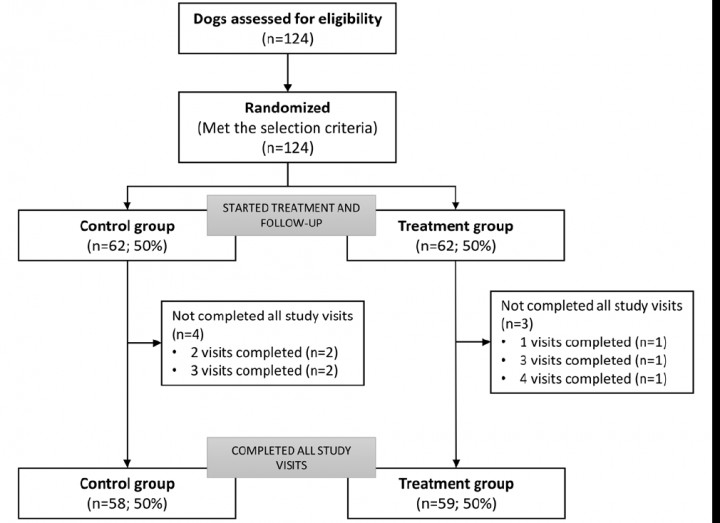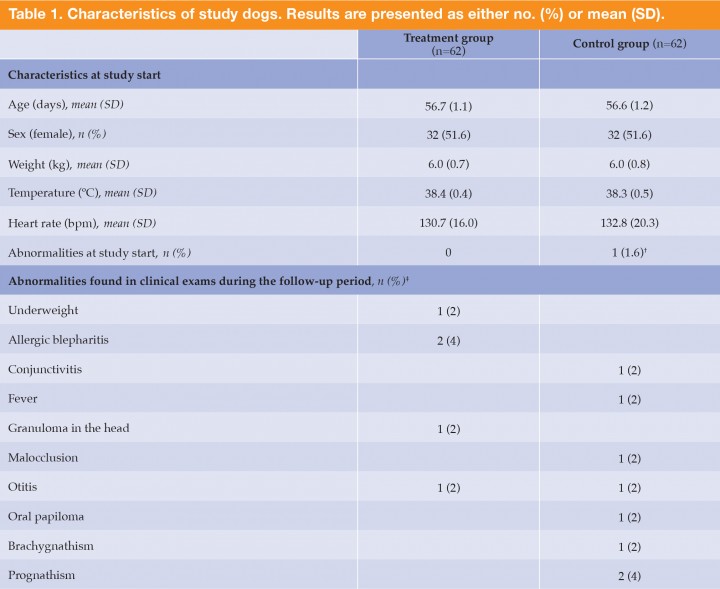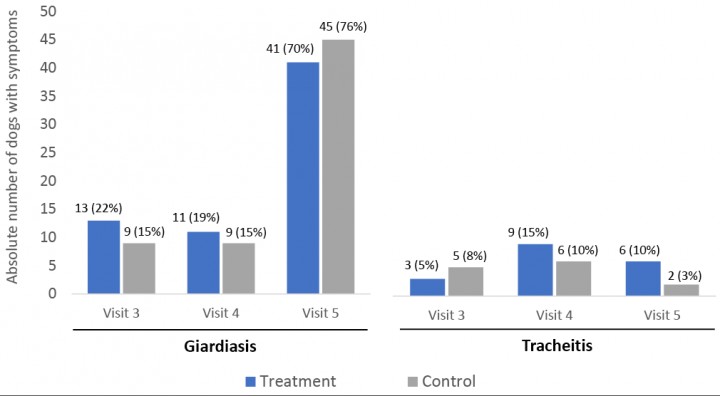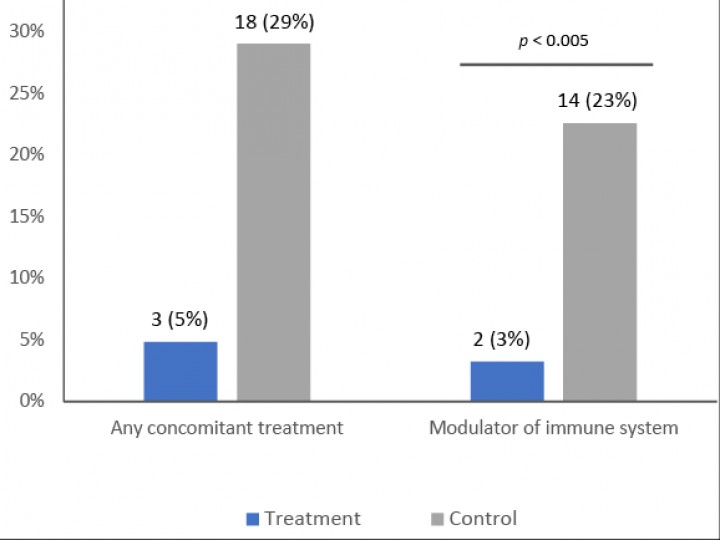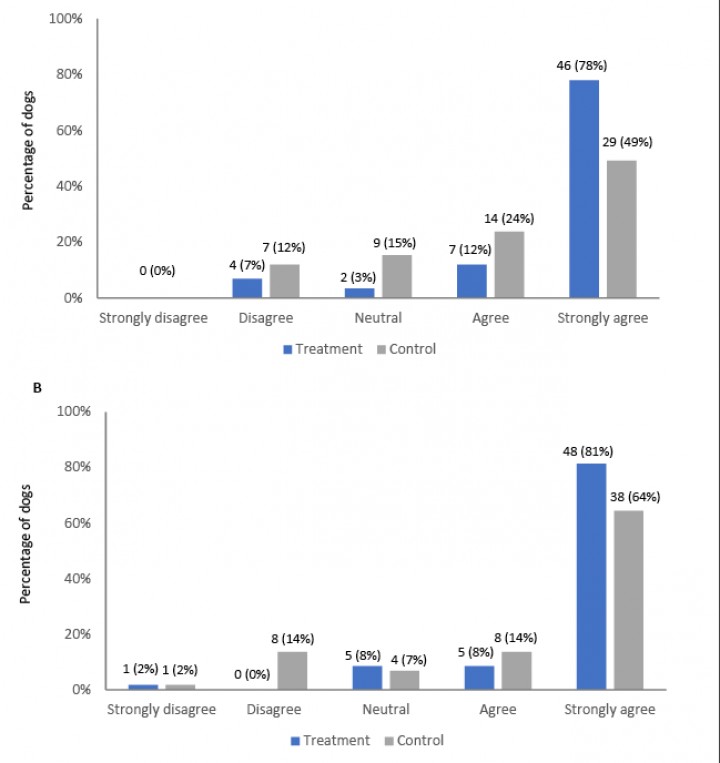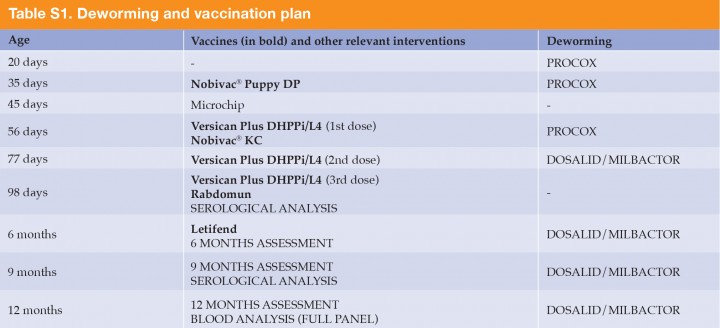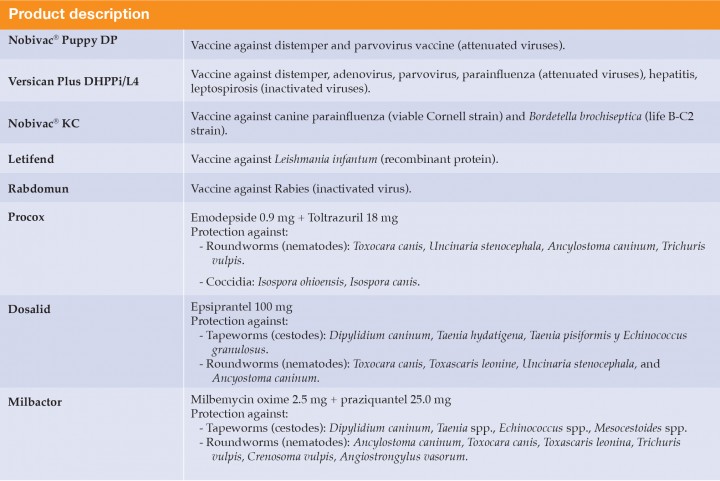Effect of oral supplementation with plasma proteins on the immune response of puppies: a randomized, controlled trial
Efecto de la suplementación oral con proteínas plasmáticas en la respuesta inmunitaria de cachorros: ensayo controlado y aleatorizado
S. Martí-Angulo, N. García-López, M. Viñarás-Otero, L. Varela-Sende
Contacto: sman@once.es
Resumen
El objetivo del presente estudio fue evaluar el efecto de la suplementación oral con proteínas plasmáticas (Plasmoral®) en la respuesta inmunitaria de cachorros de raza Labrador. Se llevó a cabo un ensayo clínico aleatorizado y con enmascaramiento simple con cachorros de Labrador de 56 días de edad. Los animales (n=124) fueron asignados aleatoriamente a un grupo tratamiento (alimentación específica y suplementación con Plasmoral®; n=62; 50 %) o control (únicamente alimentación específica; n=62; 50 %). Todos los cachorros recibieron el mismo plan de vacunación y desparasitación, y fueron regularmente evaluados por un veterinario ciego al tratamiento hasta los 12 meses de edad. Cincuenta y seis perros (95 %) en el grupo de tratamiento y 55 (93 %) en el grupo control experimentaron síntomas asociados con las enfermedades vacunales (p=1,000). Al finalizar el seguimiento los dos grupos tenían concentraciones similares de IgG (media 13,6 mg/mL y 14,6 mg/mL en el grupo tratamiento y control, respectivamente; p=0,388) y de IgA (1,1 mg/mL vs. 0,8 mg/mL; p=0,282). La frecuencia de diarrea se redujo significativamente en los perros tratados, mientras que esta tendencia no fue significativa en los del grupo control. El análisis de seguridad reveló la necesidad de medicación concomitante en tres perros (5%) del grupo tratamiento y 18 (29 %) del grupo control (p<0,001), mayoritariamente moduladores del sistema inmune (2 [3%] vs. 14 [23%]; p<0,005). De acuerdo a la evaluación del veterinario, 53 (90 %) perros en el grupo tratamiento y 43 (73 %) en el control mejoraron su estado de salud general (p=0,001). En resumen, la suplementación oral de cachorros de Labrador con Plasmoral® no mejora la inmunidad específica de las enfermedades vacunales, pero sí la respuesta inmune general.
Palabras clave: proteínas del plasma, vacuna, suplementación oral, respuesta inmune, cachorros.
Clin Vet Peq Anim 2022, 42 (1): 15-24
Summary
The aim of this study was to assess the effect of an oral supplement based on pig plasma proteins (Plasmoral®) on the immune response of Labrador Retriever puppies. We conducted a single-blind, randomized controlled trial including Labrador Retriever dogs aged 56 days. The animals (n=124) were randomly assigned to either a treatment group (specific feeding and Plasmoral® supplementation; n=62; 50%) or control group (specific feeding alone; n=62; 50%). All dogs received the same vaccination and deworming plan and were periodically assessed by a blinded veterinarian up to 12 months of age. Fifty-six dogs (95%) in the treatment group and 55 (93%) in the control group experienced symptoms associated with vaccine-targeted diseases (p=1.000). At the end of the follow-up period, the two study groups had similar concentrations of IgG (mean of 13.6 mg/mL and 14.6 mg/mL in the treatment and control groups, respectively; p=0.388) and of IgA (1.1 mg/mL vs. 0.8 mg/mL; p=0.282). The frequency of diarrhoea significantly decreased in treated dogs, whereas this trend was not significant in control dogs. Safety results showed that three dogs (5%) in the treatment group and 18 (29%) in the control group required concomitant medication (p<0.001), mostly modulators of the immune system (two [3%] vs. 14 [23%]; p<0.005). According to veterinary assessment, 53 dogs (90%) in the treatment group and 43 (73%) in the control group had improved their overall health status (p=0.001). In summary, oral supplementation of Labrador Retriever puppies with Plasmoral® does not improve specific immunity to diseases for which they were vaccinated, but it does improve their overall immune response.
Keywords: plasma protein, vaccine, oral supplementation, immune response, puppies.
Clin Vet Peq Anim 2022, 42 (1): 15-24

La presencia de este logo en un artículo de la revista indica que se publicará un examen sobre el mismo en la plataforma AVEPA Elearning. Su resolución aporta 0,15 créditos dentro del sistema de acreditaciones de especialidades veterinarias de AVEPA.
Introduction
During the first few months following birth, puppies have to deal with a non-sterile environment as their immune system matures.1,2 Although this process occurs naturally, it has been proposed that diet supplementation may improve immune responses at this stage.3-6 One of the most remarkable examples of diet supplementation is bovine colostrum, which has shown to improve immune response in dogs, even in a regular vaccination setting.3,4 The mechanism of action of colostrum extracts is not well understood. However, immunological enhancement has been attributed to changes at both systemic and intestinal mucosa levels mediated by growth factors, antimicrobial compounds, and immunomodulatory compounds present in the colostrum.
In addition to colostrum extracts, blood derivatives have been extensively used in the food industry to increase the nutritional value of animal diets. One of the properties attributed to blood derivatives, particularly the globulin fraction of plasma, is their capacity to enhance the immune response by multiple pathways that may include binding virus, bacteria, and toxins, and stimulating the immune system to produce active biopeptides.5,6 Owing to the production benefits of good immune system performance in animals reared for intensive farming, early-weaned pigs are often supplemented with spray-dried porcine plasma.7,8 However, the use of plasma protein extracts in small animals has been little investigated.9
The maturation of the immune system during the first months of life of a dog occurs in the context of a vaccination plan, which is a mainstay for the safe and healthy rearing of companion animals.2 Although puppies can develop immune responses similar to adults, the extent of these seems to depend on the maturation of their immune system. In addition to vaccine failures, presumably due to insufficient immune responses, vaccines may be associated with undesired biological effects,10-12 which are more often reported in dogs and cats despite the lower vaccination burden compared with large animals.13 The mechanisms driving vaccine failure and adverse events are not well understood, their research often being challenged by the difficulty to establish causality. Nevertheless, it seems reasonable to assume that the adequate performance of the immune system plays an essential role in the overarching goal of vaccination and other measures taken to protect companion animals from diseases.
In this randomized trial, we investigated the effect of a newly developed supplement based on an extract of pig plasma proteins (Plasmoral®, Pharmadiet, Barcelona) on the immune response of Labrador Retriever puppies. To ensure a well-controlled research environment, the product was tested on litters reared within the training program of the ONCE Foundation for Guide Dogs (FOPG). In addition to the highly controlled pedigree, which increases the genetic homogeneity of the sample, litters reared within the FOPG environment follow standardized routines and are closely monitored until the animals are ready to perform as guide dogs. Our research included exhaustive monitoring of the immune response and clinical progression of the enrolled puppies during their first year.
Materials and Methods
Animals and study overview
This prospective study included healthy Labrador Retriever dogs aged approximately 56 days and selected by the FOPG to be trained as guide dogs. At study entry and before transfer to the household, 124 dogs born in 25 litters were randomly assigned in a 1:1 ratio into one of the following groups: the treatment group (n=62; 50%; which received specific feeding and Plasmoral® supplementation; OPKO Health Spain) and the control group (n=62; 50%; which received specific feeding alone) (Fig. 1). Simple randomization was performed by an external Contract Research Organization using the Random Allocation Software (v 1.0). Following the standard program of the FOPG, dogs were transferred to previously selected homes for nurturing in a household environment until the beginning of training at 12-month old. During this period, dogs were assigned to a caretaker, who was responsible for following the nurturing program provided by the FOPG and attending regular follow-up visits to the FOPG veterinary service for health controls. The animal welfare committee of the FOPG (Madrid, Spain) approved the study protocol.
Figura 1
Flow-chart of animal inclusion and allocation.
Care plan and study visits
All dogs were fed with Hill's™ Science Plan™ Puppy Large Breed Chicken. Additionally, dogs in the treatment group started Plasmoral® supplementation at the age of 3 months, which was administered with regular food in the following regimen: dogs up to 40 kg received one tablet per 10 kg daily (tablets were split for intermediate dosing), and dogs over 40 kg received a fixed dose of four tablets. Concomitant treatments were allowed; all treatments administered were reported (along with the diagnosis for which they were intended), as did all changes in diet introduced due to discomfort. The deworming and vaccination plan is detailed in Table S1 (See Annex 1, Supplementary Tables). Dogs attended five study visits at the age of 56 days (visit 1), 98 days (visit 2), 180 days (visit 3), 270 days (visit 4), and 365 days (visit 5).
The presence of vaccine-targeted diseases was tested at visit 2 (98 days) and visit 5 (365 days): Giardia (presence of the antigen), Parvovirus (antibody ≥1/80), canine distemper (antibody ≥1/80), Rickettsia (antibody ≥1/80), Ehrlichia (antibody ≥1.1), Brucella canis (presence of antibody), Leishmania (antibody >0.55), Leptospira (antibody ≥1/200). The presence of Brucella canis, Leishmania, and Leptospira was also investigated at visit 4 (270 days). Weight gain was monitored at all study visits, taking as a reference the weight at visit 1.
Outcomes
The primary objective was to investigate the effect of oral supplementation on the immune system performance, assessed based on the frequency of symptoms associated with vaccine-targeted infections: Rickettsia, Giardia, parvovirus, Distemper, and tracheitis (details regarding symptoms associated with each infection are provided in Annex 1, Supplementary material). Other outcomes included IgG and IgA levels, and frequency (i.e., the presence or absence) of diarrhoea and enteritis, and of other unspecific events such as cystitis, conjunctivitis, dermatitis, and otitis. Enteritis was differentiated from diarrhoea by the presence of fever, abdominal pain on palpation, vomiting and/or weight loss. General IgG and IgA levels were determined by radial immunodiffusion, whereas specific IgG and IgA were determined by enzyme-linked immunosorbent assay (ELISA) or indirect immunofluorescence.
In addition to clinical and laboratory assessments, the veterinarian and the caretaker assessed the overall health status of the animal and the adequacy of the product using two single-item questionnaires: “The animal gets less frequently sick; they look more active and vigorous” and “The product is easy to use, adequately dosed, and no relevant issues regarding its administration are observed”. Both items were rated on a 5-point Likert scale: Strongly disagree, Disagree, Neutral, Agree, and Strongly agree. All study outcomes were assessed at visits 3 (180 days), 4 (270 days), and 5 (365 days).
Statistical analysis
All analyses presented in this manuscript were performed on the intention-to-treat sample. Categorical variables are described as frequency and percentage of each category, whereas continuous variables are presented as mean and standard deviation (SD). The category percentages of the two groups were compared using the Chi-squared test or the Fisher’s exact test, whereas means were compared using the T-test for independent samples. The changes in percentage of dogs experiencing a given event throughout follow-up in each group were analysed using the McNemar Test. The significance threshold was set at a two-sided alpha value of 0.05. All analyses were performed using the statistical package SAS® (version 9.4) for Windows.
Results
Animals characteristics
Table 1 summarizes the main characteristics and clinical findings of study dogs at baseline and throughout follow-up. Clinical exam at visit 1 (study start) was normal for all dogs, except one in the control group, which showed jaw prognathism. None of the mothers of the 25 litters had a relevant history of clinical diseases. All dogs were successfully dewormed and vaccinated as scheduled.
bpm: beats per minute; SD: standard deviation.
†Prognathism
‡Abnormalities are accumulated from the different visits
Symptoms related with vaccine-targeted infections
Overall, 56 (95%) dogs in the treatment group and 55 (93%) in the control group experienced symptoms associated with vaccine-targeted diseases throughout the follow-up period, with no significant differences between groups. No symptoms related to canine distemper or infection with Rickettsia or parvovirus were reported during follow-up. Dogs in both study groups reported symptoms of giardiasis and tracheitis, with no significant differences in the percentage of symptoms between groups at each study visit (Fig. 2).
Figura 2
Symptom onset of vaccine-targeted diseases in dogs that completed all study visits (n=117). Numbers correspond to the absolute frequency and percentage of dogs with any of the symptoms assessed for each disease (see Annex 1, Supplementary Methods). No symptoms related with infection with Rickettsia, parvovirus, and distemper were reported in either study group. No significant differences were found regarding the percentage of dogs experiencing symptoms in each group (p>0.05 for all inter-group comparisons).
Immune gain, clinical events, and concomitant medication
At the end of the follow-up period, the two study groups had similar concentrations of IgG (mean [SD] of 13.6 [6.4] mg/mL and 14.6 [6.2] mg/mL in the treatment and control groups, respectively; p=0.388) and of IgA (1.1 [2.1] and 0.8 [0.4] mg/mL in the treatment and control groups, respectively; p=0.28). No episodes of enteritis were reported during the follow-up period in either of the study groups. The percentage of dogs with diarrhoea at each study visit was similar in both groups and decreased throughout follow-up. However, while the decreasing trend between visits 3 and 5 in the treatment group was statistically significant (p=0.02; McNemar test), that in the control group did not reach the significant threshold (p=0.05) (Fig. 3). The overall incidence of other clinical events (i.e., not directly associated with vaccine-targeted diseases) was similar in both study groups, including cystitis (four [6.5%] and eight [12.9%] cases in the treatment and control groups, respectively; p=0.22), conjunctivitis (15 [24.2%] vs. 17 [21.4%]; p=0.68), dermatitis (12 [19.4%] vs. 10 [16.1%]; p=0.63), and otitis (13 [21.0%] vs. 12 [19.4%]; p=0.82). No treatment-related adverse events were reported during the study.
The number of dogs that required concomitant medication, prescribed by the veterinarian, was significantly lower in the treatment group; of all concomitant medications administered, modulators of the immune system were the major contributors to the observed differences (Fig. 4).
Figura 4
Use of concomitant medication during the study (n=117). Numbers correspond to the absolute frequency and percentage of dogs with diarrhoea. Modulators of the immune system were considered part of the concomitant medication.
Veterinary and caretaker assessment
At the end of the follow-up period, the (blinded) veterinarian agreed or strongly agreed that 53 (90%) animals in the treatment group and 43 (73%) in the control group had improved their overall health status (Fig. 5A). Between-group, differences regarding this assessment were statistically significant (p=0.001). Likewise, the number of caretakers that considered the animal looked healthier was significantly higher in the treatment group than in the control group (Fig. 5B): 53 (90%) and 46 (78%) caretakers in the treatment and control groups, respectively, agreed or strongly agreed on the overall improvement in the animal health status. Fifty-eight (98%) caretakers strongly agreed that the product was easy to administer and reported no issues in this regard.
Figura 5
Assessment of overall health status at visit 5 (365 days), performed by the blinded veterinary (A) and the caretaker (B). Both the veterinary and the caretaker were asked whether the animal got less frequently sick and looked more active and vigorous. Numbers represent the absolute frequency and percentage of dogs in each category. The distribution of scores was significantly different for the veterinary (p=0.01) and the caretaker (p=0.041).
Discussion
In this randomized controlled trial in Labrador Retriever puppies, we found that oral supplementation with plasma proteins significantly improved the overall health status of the animal and reduced the frequency of diarrhoea episodes compared with control dogs that had followed the same care plan without supplementation. No significant differences were observed regarding vaccination efficacy between groups.
Our results are strengthened by the highly controlled environment of the FOPG rearing program, which establishes not only a defined diet and vaccination plan but also walking routines and hygiene measures. This homogeneity avoided potential biases introduced by confounding factors other than supplementation with the investigation product. Another relevant feature for internal validity was the blinding of the veterinarian who assessed the dogs at follow-up monitoring visits. The blinded nature of the assessment is particularly important for interpreting the results regarding the use of concomitant medication, which was mostly aimed at enhancing the performance of the immune response. Hence, regardless of the actual need for immunomodulatory products, the fact that a veterinarian prescribed them while being unaware of the allocation group reflects their appraisal that the animal had poorer overall health status. In this regard, the more frequent use of concomitant medications in the control group was consistent with the significantly better scoring of the treatment group for the overall health assessment. Caretakers rated the overall health of the animals in line with the veterinarian; however, these results might be biased because of the treatment expectations of the caretaker, who was not blinded to the allocation group.
Despite that the veterinary assessment reported better health status of dogs in the treatment group, we did not find significant differences in the immunoglobulin levels nor in the frequency of symptoms associated with vaccine-targeted diseases, suggesting that the product had no significant influence on specific immunity. Oral transfer of immunoglobulins from plasma extracts has been investigated in the setting of new-born, colostrum-deprived puppies.14-16 According to these studies, oral supplementation with plasma proteins at early age failed to provide IgG concentrations comparable with the levels acquired after spontaneous maternal colostrum intake. Our results confirm this observation in the setting of first-year nourishing.
The lack of influence on immunoglobulin levels and the onset of symptoms of vaccine-targeted diseases suggest that the better overall health status reported by the blinded veterinary assessment is associated with effects other than improvements in specific immunity. One possible hypothesis to explain an enhancement of the immune response prompted by plasma proteins is the effect on intestinal microbiota. In the last decade, the relationship between the intestinal microbiome and unspecific immune response has raised interest. In humans, gut microbiota have shown to play an important role in the maturation of the intestinal lymphoid tissue, which results in an overall improvement of the immune response.17 Previous authors have suggested that oral supplementation of new-born puppies with plasma proteins increases microbial diversity in the gut.18 Although the relationship between gut microbiota and immune response has not been specifically investigated in dogs, some authors have suggested that the effects elicited by plasma proteins on gut microbiota and maturation may enhance immune response at this level.9 It is worth mentioning that most evidence regarding the effects of plasma proteins has been gathered from animals in an early stage of their lives (e.g., new-born puppies); however, it is reasonable to also expect beneficial effects on intestinal maturation of puppies between one and 12 months of age. This hypothesis is consistent with a significant decrease in the number of diarrhoea episodes observed in our study in the treatment group. Future studies investigating intestinal maturation in Labrador Retriever puppies supplemented with plasma proteins during the first year of life are warranted.
Our results should be appraised in the context of some constraints. First, our study was performed on a single, pedigree-controlled dog breed. This approach was considered optimal for a randomized controlled trial, which aims to rule out as many confounding factors as possible. However, taking into account that the performance of the immune system is not homogeneous across breeds,19 caution must be taken when inferring the applicability of the results to breeds other than Labrador Retriever. Furthermore, FOPG carefully selects litters with behaviour features suitable for guiding visually impaired people, thus increasing the likelihood of a particular genetic background of these dogs. Finally, the fact that the veterinary was allowed to prescribe concomitant medications (including enhancers of the immune system) has several implications that may challenge the interpretation of the results. As previously discussed, this approach allowed us to identify significant differences in the need of these supplements between study groups. On the other hand, however, the concomitant use of immune modulators in nearly a quarter of the puppies in the control group may have improved the performance of the immune system in these animals, thereby underestimating the effectiveness of the investigational product.
In summary, our results show that oral supplementation of Labrador Retriever puppies with plasma proteins during their first year does not improve specific immunity to diseases for which they were vaccinated, but it does improve overall immune response, manifested as better overall health status, lower frequency of diarrhoea episodes, and lower need for concomitant medication. These findings, along with the favourable safety profile, indicate that this product can be used to improve the overall health status in Labrador Retriever puppies with recurrent diarrhoea or signs suggestive of a poor immune response.
Acknowledgements
Neus Cerdà (BioClever 2005) and Gerard Carot-Sans, PhD, provided statistical and medical writing support, respectively.
Author contributions
Conceptualization: SM-A and LV-S; Formal analysis: NG-L and LV-S; Data collection: MV-O; Writing – review and editing: SM-A, NG-L, MV-O, and LV-S.
Funding: the study was promoted and funded by OPKO Health Spain.
Disclosure: SM-A has participated as speaker in sponsored educational activities of OPKO Health. LV-S is employee of OPKO Health.
ANNEX 1 – Supplementary Material
1 Supplementary Methods
1.1 Symptoms associated with vaccine-targeted infections
Rickettsia
- Fever.
- Cutaneous petechiae and ecchymoses.
- Enlarged lymph nodes.
- Anorexia.
- Depression.
- Weight loss.
- Dehydration.
Giardiasis
- Diarrhoea, characterized by a large volume of mucous and occasionally bloody stools, a light colour, very unpleasant and pervasive odour. Diarrhoea episodes may be acute, chronic, and intermittently.
- Intestinal noises.
- Swelling and abdominal pain.
- Loss of appetite or reluctance to eat.
- Weight loss, even when the dog's appetite is normal, since the body cannot take advantage of all the nutrients in the food.
- Vomiting.
Parvovirus
- Loss of appetite.
- Very severe vomiting.
- The dog seems sleepy, inactive or very tired (weakness / lethargy).
- Abundant and bloody diarrhoea.
- Fever.
- Quick dehydration.
Distemper
It often presents only with lacrimation, mucus, and cough; however, the following forms may also be present:
- Respiratory form: shortness of breath, runny nose, and cough. Secondary bacterial infections are common.
- Digestive form: gastroenteritis, with vomiting, and diarrhoea.
- Cutaneous form: dermatitis, with a thickening of the skin of the nose and the pads of the feet. This form may be associated with central nervous system symptoms.
- Nerve form: (i) in the form of sudden attacks or (ii), during the period of apparent recovery, and gradually and progressively, the animal begins experiencing muscle spasms, which lead to paralysis of the extremities (“chorea”). This symptom may be accompanied by a peculiar cough (“wheezing” cough, whistling) caused by nerve damage. In this form, the initial illness often goes unnoticed.
- Ocular form: It shows signs of conjunctivitis (lacrimation).
Concomitant infection with hepatitis B virus is frequent.
Tracheitis
- Unproductive cough, particularly when pressing on the trachea.
2 Supplementary Tables
Bibliografía
- 1.
Pastoret PP, Griebel P, Bazin H, Govaerts A: Inmunology of the dog. En Handbook of Vertebrate Immunology (ed): Academic Press, 1998; 261-288.
- 2.
Greene CE, Schultz RD, Ford RB. Canine vaccination. Vet Clin North Am - Small Anim Pract. 2001; 31(3): 473-492.
[PubMed] - 3.
Satyaraj E, Reynolds A, Pelker R, et al. Supplementation of diets with bovine colostrum influences immune function in dogs. Br J Nutr. 2013; 110(12): 2216-2221.
[PubMed] - 4.
Giffard CJ, Seino MM, Markwell PJ, Bektash RM. Benefits of bovine colostrum on fecal quality in recently weaned puppies. J Nutr. 2004; 134(8): 2126S.
[PubMed] - 5.
Gatnau R., Polo J., Robert E. Plasma protein antimicrobial substitution at negligible risk. In : Brufau J. (ed.). Feed manufacturing in the Mediterranean region. Improving safety: From feed to food. Zaragoza: CIHEAM, 2001. p. 141-150. (Cahiers Options Méditerranéennes; n. 54). 3. Conference of Feed Manufacturers of the Mediterranean, 2000/03/22-24, Reus (Spain). http://om.ciheam.org/om/pdf/c54/01600021.pdf.
- 6.
Cortese L, Christopherson PW, Pelagalli A. Platelet function and therapeutic applications in dogs: Current status and future prospects. Animals. 2020; 10(2): 1-26.
[PubMed] - 7.
Coffey RD, Cromwell GL. The impact of environment and antimicrobial agents on the growth response of early-weaned pigs to spray-dried porcine plasma. J Anim Sci. 1995; 73(9): 2532-2539.
[PubMed] - 8.
Stahly TS, Swenson SG, Zimmerman DR, Williams NH. Impact of porcine plasma proteins on postweaning growth of pigs with a low and high level of antigen exposure. Iowa State Univ swine Res Rep. 1994; 3-5.
- 9.
Mila H, Grellet A, Mariani C, et al. Natural and artificial hyperimmune solutions: Impact on health in puppies. Reprod Domest Anim. 2017; 52:163-169.
[PubMed] - 10.
Roth JA. Mechanistic bases for adverse vaccine reactions and vaccine failures. Adv Vet Med. 1999; 41: 682-700.
[PubMed] - 11.
Moore GE, Guptill LF, Ward MP, et al. Adverse events diagnosed within three days of vaccine administration in dogs. J Am Vet Med Assoc. 2005; 227(7): 1102-1108.
[PubMed] - 12.
Moore GE, HogenEsch H. Adverse Vaccinal Events in Dogs and Cats. Vet Clin North Am Small Anim Pract. 2010; 40(3): 393-407.
[PubMed] - 13.
Moore GE, Frana TS, Guptill LF, et al. Postmarketing surveillance for dog and cat vaccines: New resources in changing times. J Am Vet Med Assoc.2005; 227(7): 1066-1069.
[PubMed] - 14.
Bouchard G, Plata-Madrid H, Youngquist RS, et al. Absorption of an alternate source of immunoglobulin in pups. Am J Vet Res. 1992; 53(2): 230-233.
[PubMed] - 15.
Poffenbarger EM, Olson PN, Chandler ML, Seim HB, Varman M. Use of adult dog serum as a substitute for colostrum in the neonatal dog. Am J Vet Res. 1991; 52(8): 1221-1224.
[PubMed] - 16.
Mila H, Feugier A, Grellet A, et al. Inadequate passive immune transfer in puppies: Definition, risk factors and prevention in a large multi-breed kennel. Prev Vet Med. 2014; 116(1-2): 209-213.
[PubMed] - 17.
Arrieta MC, Stiemsma LT, Amenyogbe N, Brown E, Finlay B. The intestinal microbiome in early life: Health and disease. Front Immunol. 2014; 5(5):427.
[PubMed] - 18.
Mila H, Guard BC, Mariani C, et al. Improvement of intestinal microbiota richness in canine neonates after oral hyper-immune plasma supplementation. In: 25th Congress of European College of Veterinary Internal Medicine - Small Animals (ECVIM-CA). 2015. p. ESCG-O-4.
- 19.
Griot-Wenk ME, Busato A, Welle M, et al. Total serum IgE and IgA antibody levels in healthy dogs of different breeds and exposed to different environments. Res Vet Sci. 1999; 67(3): 239-243.
[PubMed]




